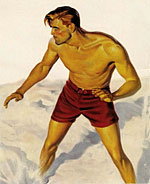
There are few original pulp artists and illustrators still living. Now there is one fewer.
Robert G. Harris, who lived just north of ThePulp.Net headquarters in Carefree, Ariz., died Sunday, Dec. 23, 2007. He was 96 and had been in failing health for several years.
When I discovered that he lived nearby just after we moved to Scottsdale, Ariz., a few years ago, I’d hoped to meet him. But word had it that he wasn’t in good health and not receiving guests.
Here is the obituary that ran in the local newspaper:
Robert George Harris, nationally known American illustrator and portrait painter, passed away peacefully on Dec. 23, 2007.
He was born Sept. 9, 1911, in Kansas City, Mo. While still attending high school, he was preparing for a career in art by attending night and summer school at the Kansas City Art Institute, studying illustration under the noted Monte Crews. He also studied at the Grand Central Art School in New York under illustrator Harvey Dunn and at the Art Students League under George Bridgeman, anatomist.
He set up his own art studio in New Rochelle, N.Y., in 1933. Artistic success soon followed with his colorful paintings of Western story covers for the pulp magazines flourishing at the time.
In 1935, he married Marjorie Elenora King, also a student at the Kansas City Art Institute. With her help and encouragement, painting story illustrations for the leading women’s magazines began in 1939 and continued for the next 30 years. His art was seen on a regular basis in the Saturday Evening Post, McCalls, Good Housekeeping, Redbook, Cosmopolitan and Ladies Home Journal. These were interspersed with illustrations for national advertising accounts — Coca-Cola, Cannon Sheets, etc.
In 1953, he moved his family to Scottsdale, Ariz., and continued in the field of illustration until 1961. At that time he was also painting portraits. He was honored in 1962 with a one-man show of portraits at the Phoenix Art Museum.
In 1970, a new home and studio was built in Carefree, Ariz., where he continued in portraiture until he retired in 1989.
His oil portraits hang in the Department of Justice, Washington, D.C., and in many private collections in the United States.
Bob is a life member of the Society of Illustrators, NYC. He is listed in Who’s Who in American Art; Who’s Who in the West; Who’s Who in Arizona; Illustrator in America 1880 to 1980; Illustrator in America 1900-1960.
His hobbies were flying, trail rides, classic cars. His is survived and well beloved by his children, (son) Craig and Susie Harris, and (daughter) Marcia and Terry Sewell, five grandchildren and five great-grandchildren.
Donations may be made to Hospice of the Valley. No services are scheduled at this time.

There’s only a slight mention of his pulp work in the obituary, but Harris contributed a string of covers for the monthly Doc Savage Magazine from November 1936 through the end of 1937. (His cover for “The Sea Angel” (November 1937), at left, was reproduced as one of the two pictures given away by Street & Smith during the magazine’s run.)
Harris’ work also graced covers for Wild West Weekly, Pete Rice Western Adventures, Double Action Western and other Western pulps.
He and his daughter, Marcia Harris Sewell, wrote “An Artist’s Life: R.G. Harris” for Illustration magazine (No. 12, December 2004), which provides a detailed look at his career. It’s accompanied by a listing of the work he did for the slicks, but not the pulps.
For many pulp artists, Harris included, the pulp magazines were just a small part of their long careers. And many prefer to be remembered for their portraits, landscapes or other fine paintings.
But for us, we’ll remember Robert G. Harris and others for their wonderful, colorful covers that leap at us from the front of the pulp magazines.
– William


Your comments